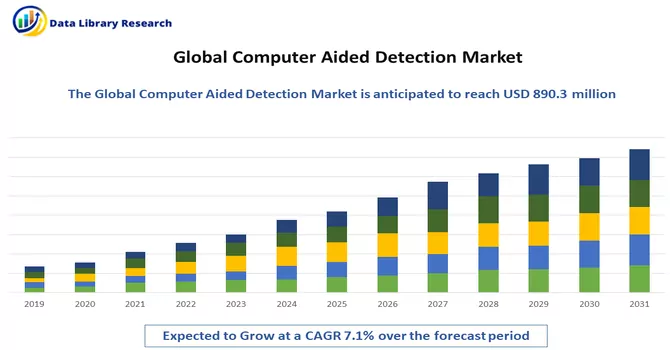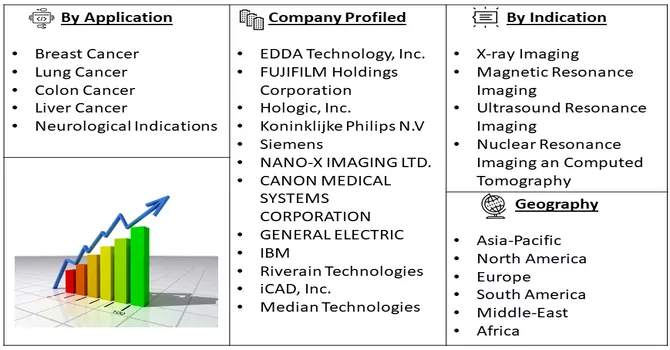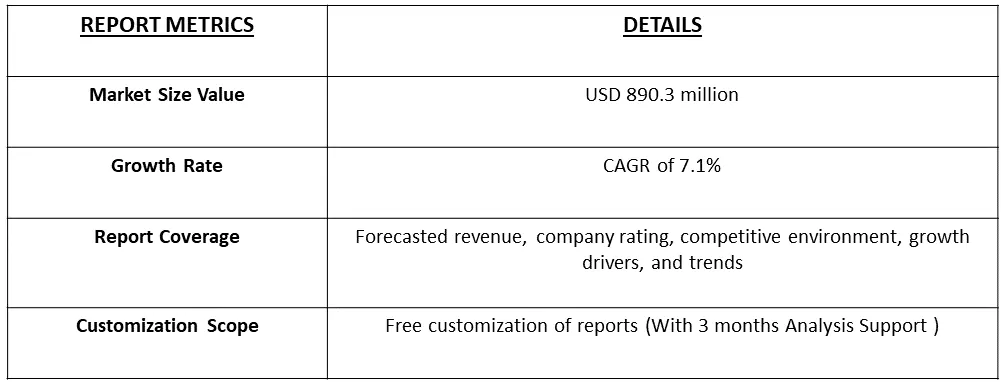The global computer-aided detection market size was valued at USD 890.3 million in 2023 and is expected to grow at a compound annual growth rate (CAGR) of 7.1% from 2024 to 2031.

Get Complete Analysis Of The Report - Download Free Sample PDF
Computer-Aided Detection (CAD) involves the use of computer algorithms to assist in the identification of abnormalities within medical images, like those from X-rays, mammography, CT scans, or MRI. CAD systems are designed to support healthcare professionals, particularly radiologists, by automatically analyzing images and highlighting potential areas of concern, such as tumors or lesions. Employing advanced image processing and machine learning techniques, CAD acts as a supplementary tool to aid in the early and accurate detection of abnormalities, ultimately improving the efficiency of medical image analysis. However, it's essential to recognize that CAD is not a substitute for the expertise of healthcare professionals; instead, it serves as a valuable adjunct to the diagnostic process, bringing attention to areas that may require further examination.
The growth of the Computer-Aided Detection (CAD) market is driven by several key factors. Firstly, the increasing prevalence of various diseases, such as cancer, has propelled the demand for advanced diagnostic tools, and CAD systems offer enhanced capabilities in detecting abnormalities in medical images, fostering early and accurate diagnoses. Secondly, technological advancements in image processing, machine learning, and artificial intelligence have significantly improved the accuracy and efficiency of CAD systems, making them more attractive to healthcare providers. Additionally, the rising adoption of digital imaging technologies across medical facilities has created a conducive environment for CAD integration. Furthermore, a growing awareness among healthcare professionals about the benefits of CAD in improving diagnostic accuracy and workflow efficiency contributes to market expansion. Moreover, the global trend towards personalized medicine and the need for precise and timely medical interventions further fuel the demand for CAD solutions. Finally, supportive government initiatives, investments in healthcare infrastructure, and collaborations between technology developers and healthcare institutions are pivotal in driving the growth of the CAD market.
Several notable market trends are shaping the landscape of the Computer-Aided Detection (CAD) market. Firstly, there is a noticeable shift towards the integration of artificial intelligence (AI) and deep learning techniques in CAD systems, enhancing their ability to analyze complex medical images with higher accuracy and efficiency. Additionally, the CAD market is witnessing a surge in the development of cloud-based solutions, allowing for centralized data storage, accessibility, and real-time collaboration among healthcare professionals. Another trend is the increasing focus on multi-modality CAD, where the technology is applied across various imaging modalities, such as X-rays, CT scans, and MRIs, providing a more comprehensive diagnostic approach. Furthermore, there is a growing emphasis on CAD applications in preventive healthcare, with a focus on early detection and monitoring of diseases, contributing to more effective treatment strategies. Interoperability and seamless integration with existing healthcare information systems also stand out as trends, facilitating smoother workflow integration for healthcare providers. Lastly, the CAD market is experiencing a rise in research and development activities aimed at exploring new applications, including areas beyond radiology, such as pathology and dermatology, expanding the potential scope of CAD technologies in the medical field.
Market Segmentation: Computer Aided Detection Market Size, Share & Trends Analysis Report By Application (Breast Cancer, Lung Cancer, Colon Cancer, Liver Cancer, Neurological Indications), Indication (X-ray Imaging, Magnetic Resonance Imaging, Ultrasound Resonance Imaging, Nuclear Resonance Imaging an Computed Tomography) and Geography (North America, Europe, Asia-Pacific, Latin America, and Middle East & and Africa). The market size and forecasts for all the above segments are provided in terms of value (USD Billion) for all the above segments.

For Detailed Market Segmentation - Download Free Sample PDF
Market Drivers:
Increasing prevalence of various diseases, particularly cancer, drives the demand for advanced diagnostic tools
The escalating prevalence of diverse diseases, notably cancer, is a primary catalyst propelling the demand for advanced diagnostic tools and fueling the growth of the Computer-Aided Detection (CAD) market. As the global burden of diseases continues to rise, there is an imperative need for diagnostic solutions that can provide early and accurate detection, enhancing the chances of successful intervention and treatment. CAD systems play a pivotal role in this scenario, leveraging advanced algorithms and image processing to assist healthcare professionals in identifying abnormalities within medical images, particularly in oncology-related screenings such as mammography and other imaging modalities. The drive for improved diagnostic accuracy, coupled with the rising awareness of the benefits of CAD in early disease detection, underscores the critical role that these technologies play in addressing the increasing prevalence of diseases, ultimately contributing to more effective and timely healthcare interventions.
Technological advancements
Technological advancements stand as a key driver in the evolution of the Computer-Aided Detection (CAD) market, revolutionizing the landscape of medical imaging and diagnosis. The continual progress in image processing, artificial intelligence (AI), and machine learning has significantly enhanced the capabilities of CAD systems. Advanced algorithms now enable CAD to analyze medical images with unprecedented precision, providing healthcare professionals with valuable insights for early and accurate detection of abnormalities. The integration of AI in CAD allows for more sophisticated pattern recognition, improving the system's ability to identify subtle nuances in medical images, such as early signs of diseases or abnormalities. This not only enhances diagnostic accuracy but also contributes to the efficiency of healthcare workflows. Moreover, the advent of digital imaging technologies has played a pivotal role in the synergy with CAD. The seamless integration of CAD with various imaging modalities, including X-rays, mammography, CT scans, and MRIs, has expanded its applicability across a wide range of medical fields. As technological innovations continue to unfold, CAD systems are anticipated to become more versatile and capable, offering solutions not only for traditional radiology but also for emerging applications in areas like pathology and dermatology. The dynamic interplay between technological advancements and the CAD market not only elevates the quality of medical diagnoses but also positions CAD as an indispensable tool in the era of modern healthcare.
Market Restraints:
Unfavorable reimbursement policies
Unfavorable reimbursement policies pose a significant impediment to the growth of the Computer-Aided Detection (CAD) market, as they create financial uncertainties and deter healthcare providers from investing in advanced diagnostic technologies. The economic viability of CAD systems is intricately tied to reimbursement structures, and issues such as inadequate reimbursement rates or complex reimbursement processes may hinder the widespread adoption of CAD technologies. The lack of clear and consistent reimbursement frameworks not only affects healthcare providers' willingness to invest in CAD but also creates uncertainty for manufacturers, limiting the accessibility of these advanced diagnostic tools for patient care. Addressing these challenges requires collaborative efforts and advocacy for fair reimbursement policies that align with the value proposition of CAD in enhancing diagnostic accuracy and patient outcomes.
The COVID-19 pandemic has had a significant impact on the Computer-Aided Detection (CAD) market in the healthcare sector. While the immediate focus during the pandemic has been on addressing and managing the virus, the overall healthcare landscape has undergone transformative changes, influencing the CAD market dynamics. The demand for CAD solutions has been influenced by the disruptions caused by the pandemic, with an increased emphasis on remote healthcare and diagnostic capabilities. The need for efficient and reliable diagnostic tools, including those integrated with CAD technology, has become more pronounced as healthcare systems strive to adapt to the challenges posed by the pandemic. Furthermore, the pandemic has accelerated the adoption of telemedicine and remote diagnostics, creating a conducive environment for CAD technologies to play a crucial role. The ability of CAD systems to aid in the interpretation of medical images remotely has become especially valuable, facilitating timely and accurate diagnoses even when physical access to healthcare facilities is restricted. On the flip side, the economic uncertainties and budget constraints induced by the pandemic may have influenced the investment decisions of healthcare institutions, affecting the pace of CAD adoption. Despite these challenges, the long-term outlook for the CAD market remains positive, driven by the growing recognition of the importance of advanced diagnostic tools and the ongoing digital transformation in healthcare. Thus, while the immediate impact of COVID-19 introduced challenges and shifts in priorities, the pandemic has also underscored the importance of technology, including CAD, in reshaping the future of healthcare delivery. The CAD market is likely to continue evolving as it plays a crucial role in supporting healthcare systems in the post-pandemic era.
Segmental Analysis:
Neurological Indications Segment is Expected to Witness Significant Growth Over the Forecast Period
Neurological indications represent a burgeoning frontier for the Computer-Aided Detection (CAD) market, offering promising prospects for advancements in diagnostic capabilities within the field of neuroimaging. As the demand for precise and early detection of neurological disorders such as brain tumors, aneurysms, and neurodegenerative diseases continues to rise, CAD systems are increasingly being integrated into neuroimaging workflows. Advanced algorithms and artificial intelligence-driven image analysis in CAD facilitate the identification of subtle abnormalities in neuroimaging studies, providing valuable support to healthcare professionals in accurate diagnosis and treatment planning. The CAD market's expansion into neurological applications not only signifies a paradigm shift in neurodiagnostics but also underscores the potential for these technologies to significantly improve patient outcomes by enabling swift and accurate detection of neurological conditions. As research and development in neuroimaging technologies progress, the intersection of neurological indications and CAD is poised to play a pivotal role in shaping the future landscape of diagnostic tools and methodologies in the realm of neurological healthcare.
Ultrasound Resonance Imaging Segment is Expected to Witness Significant Growth Over the Forecast Period
The integration of ultrasound imaging and CAD technologies represents a significant development in medical diagnostics. Ultrasound, a widely used imaging modality for various medical applications, benefits from CAD systems that employ advanced algorithms and artificial intelligence. These technologies assist healthcare professionals in the interpretation of ultrasound images, enhancing diagnostic accuracy and efficiency. In applications like breast imaging, obstetrics, and abdominal studies, CAD can help identify subtle abnormalities or lesions, providing valuable support for timely and accurate diagnoses. The synergistic combination of ultrasound and CAD not only improves the diagnostic process but also holds the potential to expand the range of applications for ultrasound imaging, contributing to the overall growth of the CAD market in the realm of medical diagnostics.
North America Region is Expected to Witness Significant Growth Over the Forecast Period
The dominance of North America in the computer-aided detection (CAD) market can be attributed to the increasing healthcare expenditure, propelling overall healthcare growth within the region. The substantial investment in healthcare infrastructure and technology, coupled with a higher adoption rate of computer-aided detection (CAD) systems, especially for cancer diagnosis, further solidifies North America's leading position. The region's commitment to advancing medical technologies and its robust healthcare ecosystem contribute to the widespread integration of CAD in diagnostic practices, positioning North America as a frontrunner in the CAD market. The emphasis on early and accurate detection, particularly in cancer-related diagnoses, underscores the pivotal role of CAD technology in shaping the healthcare landscape across North America.

Get Complete Analysis Of The Report - Download Free Sample PDF
To enhance their market standing, key industry players employ diverse strategies, including the introduction of novel products and engaging in mergers, collaborations, partnerships, and acquisitions. Many participants in the market are now executing strategic plans tailored to meet the demands of consumers. This involves the implementation of measures that align with market needs and trends, ensuring a proactive approach to addressing challenges and capitalizing on opportunities. The industry landscape is marked by a dynamic environment where companies continually seek to innovate and forge alliances, positioning themselves strategically to stay competitive and responsive to evolving market demands. The following are some of the major participants in the global computer aided detection market:
Recent Development:
1) In Feb 2023, The successful development of high-sensitivity algorithms for lesion detection in automated digital breast tomosynthesis (DBT) is poised to positively impact the Computer-Aided Detection (CAD) market. These advanced algorithms showcase improved accuracy in breast cancer diagnosis, potentially increasing the adoption of CAD systems. The integration of artificial intelligence and machine learning into CAD solutions may become more prevalent as healthcare providers seek enhanced diagnostic capabilities. Positive outcomes from AI challenges, like the recent one reported in JAMA, are likely to instill greater confidence among healthcare professionals, fostering increased adoption of CAD technologies. As a result, the CAD market is expected to experience heightened interest, investments, and innovation in support of more effective breast cancer detection.
2) The successful development of high-sensitivity algorithms for lesion detection in automated digital breast tomosynthesis (DBT) is poised to positively impact the Computer-Aided Detection (CAD) market. These advanced algorithms showcase improved accuracy in breast cancer diagnosis, potentially increasing the adoption of CAD systems. The integration of artificial intelligence and machine learning into CAD solutions may become more prevalent as healthcare providers seek enhanced diagnostic capabilities. Positive outcomes from AI challenges, like the recent one reported in JAMA, are likely to instil greater confidence among healthcare professionals, fostering increased adoption of CAD technologies. As a result, the CAD market is expected to experience heightened interest, investments, and innovation in support of more effective breast cancer detection.
Q1. What is the current Computer Aided Detection Market size?
The global computer-aided detection market size was valued at USD 890.3 million.
Q2. What is the Growth Rate of the Computer Aided Detection Market?
Computer Aided Detection Market is expected to grow at a compound annual growth rate (CAGR) of 7.1% over the forecast period.
Q3. Which is the leading Component Segment in the Computer Aided Detection Market?
Neurological indications Segment and Ultrasound Resonance Imaging Segment is the leading componets of the Computer Aided Detection Market.
Q4. Which Region is expected to hold the highest Market share?
North America region is expected to hold the highest Market share.
Data Library Research are conducted by industry experts who offer insight on industry structure, market segmentations technology assessment and competitive landscape (CL), and penetration, as well as on emerging trends. Their analysis is based on primary interviews (~ 80%) and secondary research (~ 20%) as well as years of professional expertise in their respective industries. Adding to this, by analysing historical trends and current market positions, our analysts predict where the market will be headed for the next five years. Furthermore, the varying trends of segment & categories geographically presented are also studied and the estimated based on the primary & secondary research.
In this particular report from the supply side Data Library Research has conducted primary surveys (interviews) with the key level executives (VP, CEO’s, Marketing Director, Business Development Manager and SOFT) of the companies that active & prominent as well as the midsized organization
FIGURE 1: DLR RESEARH PROCESS

Extensive primary research was conducted to gain a deeper insight of the market and industry performance. The analysis is based on both primary and secondary research as well as years of professional expertise in the respective industries.
In addition to analysing current and historical trends, our analysts predict where the market is headed over the next five years.
It varies by segment for these categories geographically presented in the list of market tables. Speaking about this particular report we have conducted primary surveys (interviews) with the key level executives (VP, CEO’s, Marketing Director, Business Development Manager and many more) of the major players active in the market.
Secondary ResearchSecondary research was mainly used to collect and identify information useful for the extensive, technical, market-oriented, and Friend’s study of the Global Extra Neutral Alcohol. It was also used to obtain key information about major players, market classification and segmentation according to the industry trends, geographical markets, and developments related to the market and technology perspectives. For this study, analysts have gathered information from various credible sources, such as annual reports, sec filings, journals, white papers, SOFT presentations, and company web sites.
Market Size EstimationBoth, top-down and bottom-up approaches were used to estimate and validate the size of the Global market and to estimate the size of various other dependent submarkets in the overall Extra Neutral Alcohol. The key players in the market were identified through secondary research and their market contributions in the respective geographies were determined through primary and secondary research.
Forecast Model
